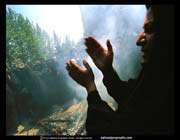دنیای زبان انگلیسی ( بهروزپور )
لغات و اصطلاح .داستان کوتاه . شعر.جوک .ضرب المثل.اشپزی.رمان. نمایشنامه.متن دوزبانهدنیای زبان انگلیسی ( بهروزپور )
لغات و اصطلاح .داستان کوتاه . شعر.جوک .ضرب المثل.اشپزی.رمان. نمایشنامه.متن دوزبانهWhat is Ashura?
What is Ashura?
In the Islamic calendar, 10th day of the month of Muharram is the day of 'Ashoora, a day of mourning for all feeling Muslims. It is the day on which, in the year of 61 Hijri (680 AD), in a place called Karbala, in Iraq, Imam Hussain, the grandson of the Prophet of Islam, sacrificed his life and the lives of many of his family members and friends, in order to save the teachings of Islam from utter distortion and destruction.
What led to this tragic event of Karbala?
Even in the lifetime of the Prophet of Islam, there were people whose tongues professed faith in Islam but whose hearts lay elsewhere. These people were called "Munafiqeen" (hypocrites) by the Holy Quran. The reasons that these people joined the ranks of Muslims were manifold, some of which were as follows:
1. Enmity towards Islam prompted them to sow discord among the Muslims from within, by distorting the Prophet's message wherever and however possible.
2. Islam was spreading fast and gaining power. They decided to join the winning side and seize whatever worldly gains they could lay their hands on.
The activities of such people gained impetus after the Prophet's passing away, and reached a peak when Muawiya, the son of Abu Sufyan, claimed himself the ruler of Syria.
The hypocrites were now in power and so they mounted a highly organized assault against the very roots of Islam, and they were on the verge of total success. Some of the priorities of the attack were to destroy the awareness of the common Muslims or to destroy their faculty of expression. This was achieved through bribes, through terror and through propagation of ignorance. When these weapons failed in silencing the tongue of a strong Muslim, then that tongue was silenced by death.
By all these means, within half a century after the Prophet's passing away, Islam had been distorted so much that it became totally unrecognizable, so unrecognizable that people knew of the debaucheries of Yazid, son of Muawiya, and still accepted him as a successor of the Prophet and a true leader of the Muslims.
With the advent of Yazid, the vilest of the vile, the mission of destroying the roots of Islam had reached its peak. The right and the wrong had been intermixed so much that it became impossible for a common man to differentiate between them.
This would have been the end of Islam, but for Hussain (AS = alayhi as-salaam, or peace be upon him), grandson of the Prophet (PBUH) and son of Ali ibn Abi Talib (AS) and Fatima az-Zahra (AS).
ادامه مطلب ...اصطلاح
ساقدوش: best man
منفی بافی :wet blanket
غرق مطالعه شدن :in brown study
بلا تکلیف :at loose ends
ادم خوش قول :an of his word
چند شغله :moonlighting
ادامه مطلب ...The Sound and the Fury :خشم و هیاهو (ویلیام فالکنر)
The Sound and the Fury is a novel written by the American author William Faulkner. It employs a number of narrative styles, including the technique known as stream of consciousness, pioneered by 20th century European novelists such as James Joyce and Virginia Woolf. Published in 1929, The Sound and the Fury was Faulkner's fourth novel, and was not immediately successful. In 1931, however, when Faulkner's sixth novel, Sanctuary, was published — a sensationalist story which Faulkner later claimed was written only for money — The Sound and the Fury also became commercially successful, and Faulkner began to receive critical attention.
In 1998, the Modern Library ranked The Sound and the Fury sixth on its list of the 100 best English-language novels of the 20th century
Plot introduction
The Sound and the Fury is set in the fictional Yoknapatawpha County. The novel centers on the Compson family, former Southern aristocrats who are struggling to deal with the dissolution of their family and its reputation. The novel is separated into four distinct sections. The first, April 7, 1928, is written from the perspective of Benjamin "Benjy" Compson, a 33-year-old man with severe mental handicaps. Benjy's section is characterized by a highly disjointed narrative style with frequent chronological leaps. The second section, June 2, 1910, focuses on Quentin Compson, Benjy's older brother, and the events leading up to his suicide. In the third section, April 6, 1928, Faulkner writes from the point of view of Jason, Quentin's cynical younger brother. In the fourth and final section, set a day after the first, on April 8, 1928, Faulkner introduces a third person omniscient point of view. The last section primarily focuses on Dilsey, one of the Compson's black servants. Jason is also a focus in the section, but Faulkner presents glimpses of the thoughts and deeds of everyone in the family.
Vanilla Cream and Strawberry Jello
Main Ingredients:
Sheida: Colorful and delicious, this will be your favorite dessert.
Strawberry jello: 1 packet
Egg yolk: 5
Milk: 2.5 cups
Sugar: 1 cup
Gelatin Powder: 5 tsp (15 ML) Or 2 packs of Knox Gelatin Powder, each contains about 7 ml.
Vanilla: 1/8 tbsp
Whipping Cream: 1/2 Cup
Fresh Strawberries or Raspberries
Mint leaves
نامه ای به خدا : The letter to God

One day, a letter came addressed in a shaky handwriting to God with no actual address.
He thought he should open it to see what it was about. The letter read
مردی برای یک اداره پست کار می کرد که مسئول رسیدگی به نامه هایی که آدرس نا معلوم داشتند بود.
یک روز متوجه نامه ای شد که روی پاکت آن با خطی لرزان نوشته شده بود نامهای به خدا !
با خودش فکر کرد بهتر است نامه را باز کرده و بخواند.در نامه این طور نوشته شده بود:
I am an 83 year old widow, living on a very small pension. Yesterday someone stole my purse.
It had $100 in it, which was all the money i had until my next pension check.
Next Sunday is Christmas, and I had invited two of my friends over for dinner.
Without that money, I have nothing to buy food with.
I have no family to turn to, and you are my only hope. Can you please help me
AndisheHaye Zendegi
شهرهای دیدنی ایران : Geography and Nature
Geography and Nature
of Iran
Covering an area of 1,648,000 square kilometers, the Islamic Republic of Iran is located in southwestern Asia. The Caspian Sea, Turkmenistan, Azerbaijan and Armenia in the north; Afqanistan and Pakistan in the east; Turkey and Iraq in the west surround the country. On the south Iran borders the Persian Gulf and the Sea of Oman. Total terrestrial borders of the country are 5,170 km. and total water borders are 2,510 km.
Caspian Sea, Gilan
Iran is situated at the heart of the Middle East and, as a bridge, links the Caspian Sea, the largest land-locked body of water in the world, to the Persian Gulf. It is also a crossroad between the East and the West. Thus, historically, Iran has been in the juncture of cultural, intellectual and political manifestations of both the East and the West, while preserving it"s unique identity.
Unique landscapes such as limpid water springs, pomegranate orchards, pistachio gardens, rows of lombardy poplars, decampment of nomads in different seasons, stelliferous nights, rocky mountains, endless high and low lands, extinct snow-clad volcanoes, dense forests of the Alborz Mountain Range, and coastlines of the Caspian Sea, the Persian Gulf and the Sea of Oman are all eye-catching and memorable.
Abumoosa Island
Iran"s landscapes vary remarkably at different seasons. They are at times full of stone and sand, at times full of floodwater, sometimes covered by snow or by lush vegetation. Iranian artists have portrayed Iran"s nature as a sign of diversity and charm in their different and diverse artistic works. Iranians also have traditionally valued Water as a symbol of life and development. Innumerable permanent streams can be seen flowing in meadows, gardens, orchards, homes, mosques and sacred places irrigating trees.Nature and it"s diversity in Iran are valuable parameters for development of the tourism industry. In total, it is estimated that 19 million hectares of terrestrial land are covered by orchards, gardens and farmlands; 10 million hectares are plain and pastures; 19 million hectares are forests; and the remaining include barren lands, desert, and mountains.
ادامه مطلب ...



